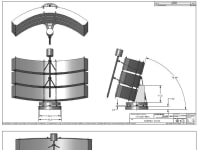
In the beginning, there was the power of the sun. It took millions of years to store the sun’s energy in the form of fossils that we are utilizing now. As we continue to deplete our fossils, the one thing missing is a clean energy source for terrestrial and off-world applications. To create the future, we must create mechanisms to directly use the clean fuel source of the sun derived from local materials.
The shortcut from the ongoing problem to the solution is a breakthrough. The solution is low-tech, mass produced, zero emissions energy on a universal scale. Sonoran Solar’s technology is real, zero emissions, zero particles, and zero oil.
Since the sun’s energy is disperse, the largest and most expensive part of any solar power generation is the collector field. There are several problems with current concentrator fields that are addressed by Sonoran Solar’s project concept. Most current systems rely on expensive, and often imported, glass and metal components that require large flat areas of land for construction and constant maintenance to counter the effects of wind and rain.
These problems and more are addressed by Sonoran Solar’s novel, yet low-tech, use of concrete parabolic trough, point focus and heliostat concentrators. Terrestrially, concrete is the most used building material. The concrete concentrators are built on-site using local labor and standard materials. The weight and durability of concrete construction protects the collector from the wind and provides resistance to corrosion. The elegant design also provides high optical concentration and accurate two axis tracking.
This technology is novel because of its inherent highly accurate surface derived from its ability to form against another manufactured surface. Forming an optical surface against a mold is not novel in itself (injected molded plastics are a good example) but using cement and straw bales in the manufacturing of a solar optic has never been done before. Sonoran Solar’s technology holds promise for the kind of radical breakthrough that will be necessary to realize distributed solar power.
Direct use of the Sun’s energy can be utilized many different ways for industrial process applications. Heat, water distillation, refrigeration, furnaces, electricity, hydrogen production, direct steam generation, are just a few.
The most versatile is electricity. The easiest and fastest implemented might be concentrators utilizing low concentrations of sun on single sun photovoltaic cells assembled on cooling yielding electricity and heat. This application can be on a small scale whereas other applications require substantial investment.
The most interesting and perhaps the most versatile use of solar concentrators is the power tower. Power towers hold promise for multiple applications for experimentation. The most exciting being a solar cement plant. The heliostats would focus on the rotating clinker furnace providing the heat eliminating pyroprocessing and emissions of the manufacture of cement. On or off-world, this would make cementious optics a CLEAN BREEDER TECHNOLOGY!
Off-world and terrestrial possibilities should include terrestrial experiments/tests that would help develop off-world processes like Mooncrete for construction of colonies where water is not plentiful.
-
Awards
-
 2012 Top 100 Entries
2012 Top 100 Entries
Like this entry?
-
About the Entrant
- Name:Jacque Neff
- Type of entry:teamTeam members:Jacque Neff
William Russum
Roy Tucker
Conrad Wells
Eugene Gross
Gene Gardner - Software used for this entry:Solid Works
- Patent status:pending








